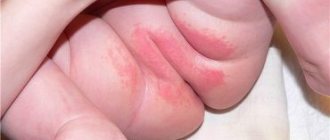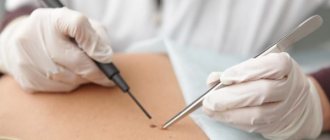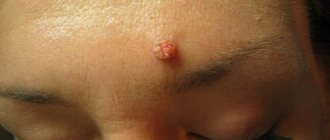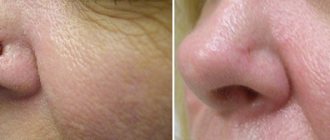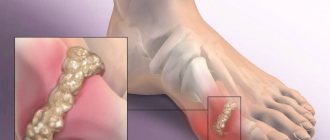Warts are classified as benign neoplasms.
They can appear on various parts of the skin and mucous membranes.
If a wart appears on the lip, it represents a cosmetic defect and can also cause discomfort to its owner, worsening the quality of life.
Forming on the lip, the tumor affects speech and interferes with eating.
A wart can cause pain, especially if it is localized on the mucous membrane inside the lip.
If measures are not taken to eliminate it, the growth may become injured, which will lead to a secondary infection.
Types of warts
A wart is a growth that rises above the surface of the skin or mucous membrane.
Its dimensions, as a rule, are no more than 1 centimeter in diameter.
The tumor can appear on any part of the body, including the face.
On the face, most often a wart forms on the lip, above or below the lip, on the buccal surface of the oral mucosa.
A warty growth can appear on both the upper and lower lips.
The following types of neoplasms are distinguished:
- Common (vulgar) warts. These are growths that have a dense structure, soft to the touch, flesh-colored or yellowish in color. New growths form on the red border of the lips. They are not painful, but tend to itch. Vulgar warts appear on the lips not only in adults, but also in children.
- Flat- shaped growths may appear on the outside of the lips or on the oral mucosa. Their surface is smooth, oval or round in shape. The color of the growth resembles the color of the skin and almost does not rise above it. The location is also the red border of the lips. Flat warts do not hurt, but they are very itchy.
- Hanging neoplasms are located on a thin stalk. At the beginning of development they resemble a bump. They have a brown, pinkish tint or close to the color of the skin.
- Filiform (acrochords). These are small growths that appear after 35 years, but can occur earlier.
- Genital warts . The localization of such growths is the mucous membrane. The new growths are elongated and arranged in groups, resembling a cockscomb or cauliflower inflorescences. The growths are prone to injury, which causes inflammation and bleeding.
The wart forms gradually and almost imperceptibly.
- At the beginning of development, a small compaction forms, which gradually increases.
- A white dot forms on the surface of the mucous membrane of the lip or in the mouth, which gradually turns into genital warts.
To date, approximately one hundred types of papillomavirus have been discovered.
Some types of growths have a benign course, while others are capable of malignancy.
They can provoke the development of cancer.
In addition to the types of growths listed above, there are also senile warts (keratoma, keratosis).
The difference between keratosis is that its appearance is not associated with papillomavirus, and keratoma does not provoke the formation of cancer.
In their development, senile warts go through several stages:
- ✓ brown spots appear, but the wart has not yet formed
- ✓ formation of papules and nodules
- ✓ appearance of keratoma - when you try to scrape off the scales, bleeding appears
- ✓ transition to the cutaneous horn, which is characterized by excessive growth and keratinization of the neoplasm
According to some experts, keratosis and senile warts belong to different diseases.
What is papillomavirus
The Human Papillomavirus (HPV) is a group of small viruses that contain DNA. These viruses cause pathologies of epithelial tissue. The main method of transmission of infection is unprotected sexual contact. Scientists have discovered more than 200 strains of HPV, of which 29 strains are oncogenic. Dangerous strains cause malignant degeneration of epithelial cells.
The relationship between HPV infection and the development of malignant tumors has been scientifically proven. The papillomavirus is integrated into the human genome, which leads to a failure of the program embedded in the DNA. When epithelial cells divide, the affected gene is transferred to new cells. This is how the virus penetrates into the deep layers of tissue.
The infection is asymptomatic until cells with an altered genome begin to reproduce cancer cells. HPV causes cancer:
- cervix;
- vulva and vagina;
- penis;
- anal canal;
- throat and larynx;
- neck and scalp;
- stomach and esophagus.
The growth of benign tumors is also possible: papillomas, condylomas, anogenital warts. Complications include recurrent respiratory papillomatosis (in adults and children). This disease leads to difficulty breathing and obstruction of the airways.
The difference between a wart and keratoses and cancer
Keratosis may be similar in appearance to melanoma (a type of skin cancer).
Melanoma can begin as a warty growth or as a seborrheic keratosis.
A dermatologist can distinguish them from cancer.
To exclude an oncological process, a biopsy is performed.
The peculiarity of seborrheic keratosis is that the formation is waxy, flat, and there is no pain when touched or at rest.
With cancer, a growth similar to a keratosis may change shape or color.
In this case, you will need to consult a specialist.
HPV: can it be treated or not?
It happens that papillomavirus is cleared from the body within two years after infection. But this is typical mainly for children and young people. However, since the prevalence of the virus is high, there is a risk of re-infection (relapse). Immunity after an illness is not formed for life, but for 1–3 years. It is this fact that underlies the statement that HPV cannot be cured.
In most cases, in adults, the papillomavirus does not leave the body on its own, but is integrated into the genome, provoking the development of tumors, including cancer. We advise you not to rely on luck, but to start treatment at the first symptoms of the disease. Human papillomavirus infection is successfully treated with modern medicine. New growths on the skin are removed using destructive methods.
Effective treatment is possible only according to the regimen proposed by the attending physician. When prescribing therapy, the dermatovenerologist takes into account the HPV strain, the degree of oncogenicity, and the patient’s immune system. Self-selection of medications will most likely not give the desired result. After therapy, you need to get tested for HPV every 2 years to avoid relapse of the disease.
Causes of warts
The appearance of warts is caused by infection with papillomavirus or HPV.
Since the skin on the lips is quite thin, it is therefore easily permeable to viruses.
It should be noted that signs of infection with the human papillomavirus do not always occur.
The better the immune system, the less likely it is that symptoms of the disease will appear.
And yet, most of the world's population is infected with HPV.
The incubation period for the development of the disease can be several months or years.
As soon as the immune system fails, the first signs of infection appear.
Activation of the virus is accompanied by the formation of warts.
As a rule, growths appear on the area of the skin or mucous membrane where the pathogen entered the body.
Infection can occur both through sexual contact and through household contact.
Can the virus be transmitted by kissing on the lips?
The most common cases of infection are:
- intrauterine infection of the fetus if a pregnant woman is infected with papillomavirus
- shaking hands or kissing an infected person (if there are wounds or abrasions, the risk of infection increases)
- the use of personal items of an infected person (toothbrush, dishes, lipstick) is unlikely, since the pathogen is not stable in the environment
- sex accompanied by oral sex
- visiting common areas (swimming pool, sauna, shower)
People at risk are those who:
- patients with diabetes mellitus or other pathology of the endocrine system
- suffer from obesity and metabolic disorders
- taking antibiotics for a long time
- have chronic diseases
- suffer from increased sweating, especially on the feet, as this is where plantar warts often form
A malfunction of the immune system can occur for the following reasons:
- If there is a deficiency of essential substances in the body
- After suffering stress or physical exhaustion
- In case of hormone imbalance: during puberty, during pregnancy, with the onset of menopause, during treatment with hormonal drugs
- In case of chronic lack of sleep and overwork
- Due to a recent infectious disease
- If a person abuses smoking and alcoholic beverages
Intraductal papilloma (ductal papilloma).
Removal of papilloma on the nipple
Ductal papilloma (intraductal papilloma) occurs near the nipple; removal of papilloma on the nipple is possible using electrocoagulation under local anesthesia. Signs of intraductal papilloma (or nipple papilloma) are the appearance of blood-stained or transparent discharge from one nipple. Ductal papilloma is often a precancerous condition. Treatment of papillomas on the nipple and intraductal papilloma is carried out by a mammologist-oncologist.
On the picture:
papillomas on the face
The human papillomavirus (HPV) is widespread throughout the world. HPV causes warts, papillomas, and genital warts. Different types of human papillomavirus (there are more than 100 of them) cause different diseases.
Genital warts are small skin-colored formations, their size ranges from 1 mm to several centimeters. Genital warts can form on the genitals, near the anus, on the face, even in the mouth, on the body, abdomen, in the groin area, and in the armpits. This is a viral disease. The causative agent of genital warts is the human papillomavirus (HPV).
In men, the glans penis and frenulum of the foreskin are most often affected. In women, damage by the human papillomavirus appears on the labia, clitoris, vagina, and cervix.
Genital warts can be localized around the anus.
From single ones, genital warts can grow into rashes that can spread, taking on the appearance of cauliflower. “High-risk” HPV types (16, 18, 31, 33 and 35) cause cervical dysplasia and can become malignant.
Diagnosis of warts
The main diagnostic method is to examine the patient's face for the presence of warts on the lips and oral mucosa.
To confirm or refute the presence of HPV, it is enough to take tests:
- ✓ Blood tests for antibodies
- ✓ To conduct a histological examination (biopsy), a small part of the tumor is taken for analysis
- ✓ The PCR technique allows you to detect the genetic material of a pathogen with one hundred percent probability
Before getting rid of the growth, you should visit an oncologist.
A specialist will use dermatoscopy to determine the condition of the wart to rule out signs of malignancy.
Clinical picture
Condylomata acuminata are formations of flesh-pink color, lobulated, ranging in size from 2 millimeters to ten centimeters, with exophytic growth, in which the apex of the genital condyloma is often wider than the base. Externally, the growths may resemble cauliflower or cockscomb.
The incubation period can range from 2-3 months to 2-3 years or more. The growth rate of formations varies, which is often associated with the state of local immunity, the presence of concomitant STIs, and sexual activity.
Clinical manifestations of warts on the lip
A wart on the lip does not appear the next day after the papilloma virus enters the body.
The incubation period can last from six months to several years.
This often occurs when the immune system malfunctions.
Having penetrated the skin or mucous membrane, the virus integrates its genetic material into human cells and thus begins to multiply.
As a result, characteristic neoplasms appear at the site of virus introduction.
The pathogen provokes warty growths, disrupting the processes of keratinization of the skin.
Oncogenic strains of papillomavirus change the genetic apparatus of cells in such a way that a malignant formation is formed.
HPV prevention methods
For the development of the disease, it is enough for several small viruses to enter the body. Prevention methods will help prevent infection or recurrence of the disease:
- Use barrier contraception during sexual intercourse.
- Avoid public swimming pools, baths, saunas.
- Strengthen the body's immune system.
- Avoid stress and nervous overload.
- Dress warmly and avoid hypothermia.
We advise women to undergo a gynecological examination and tests for infections at least once a year. This will help maintain the health of the reproductive system.
Is it necessary to remove a wart on the lip?
Removal of the tumor is carried out if there are indications for this.
The growths sometimes disappear spontaneously.
Therefore, if the wart is small and does not cause much concern, then there is no need for removal.
The decision to excise the growth must be made by a specialist.
If a wart causes discomfort in the form of itching, burning, pain, grows, becomes inflamed, or changes in appearance.
If it has increased in size, changed shape and color, or is bleeding, then it must be removed by resorting to excision by one of the methods.
Removing a tumor at home is not safe.
As a result of incorrect actions:
- It may not be possible to remove the wart completely, which will cause its reappearance
- the risk of injury to healthy tissues that surround the growth increases
- scars and cicatrices may form
Wart treatment
Treatment of any growth on the lips begins with a medical examination and determining whether the growth is malignant.
Next, the doctor selects a method of therapy.
In case of a malignant form, the patient is referred to an oncologist, who will decide how to treat the patient.
Treatment of the disease is complex.
Treatment consists of the main stages: removal of the growth and drug therapy.
Removal of the tumor can be done in one of the following ways:
- ✓ Using pharmaceutical products
- ✓ In a medical institution where modern excision techniques will be used
- ✓ Folk remedies. The use of alternative medicine methods must be agreed with a doctor
Advantages of the Private Practice Clinic
- Certification in all areas of work.
- The consultation is conducted by experienced dermatovenerologists and gynecologists.
- The latest methods of treating diseases.
- Possibility of removing papillomas and condylomas using all currently known modern methods without pain and serious scars.
- Results of express tests on the day of treatment.
- Individual approach to each patient.
- Polite and friendly staff.
- You can undergo diagnosis and treatment anonymously.
- Convenient location of the clinic in the center of Moscow and Southern Administrative District.
- Parking for visitors to the medical center.
Pharmacy products for removing warts
You can buy medications at the pharmacy that will help you deal with warts at home.
Among them:
- Super clean . The product is an alkaline solution that has a chemical effect on the growth, causing cauterization.
- Cryopharma, Wartner . These agents cause cryodestruction of the wart; as a result of cold exposure, the neoplasm is frozen.
- Solcoderm . A drug containing acids that have a cauterizing and mummifying effect on pathological tissues.
- Immunomodulators – Viferon, Oxolinic ointment will help increase immunity and the body’s fight against the virus.
- Antiviral agents – Isoprinosine, Interferon.
The use of cauterizing agents on the lips and face is extremely undesirable; application of these agents to the oral mucosa is especially dangerous.
Wart removal in the clinic
The clinic uses modern hardware techniques to excise growths:
- Laser therapy . The method allows you to quickly and without blood remove the growth. There is no discomfort during the procedure, as pain relief is performed. During one session, you can get rid of several tumors in a very short time. The method is suitable not only for adults, but also for children. The likelihood of relapse is minimized. Skin defects in the form of scars after laser use are very rare.
- Radio wave therapy . The technique is considered the safest. When excising a wart using a radio wave, there is no contact with the skin. It is not always possible to completely remove the growth. The procedure leaves no traces of impact.
- Electrocoagulation . The procedure requires anesthesia. Using an electrode to which a high-frequency electric current is applied, the wart is burned out, followed by cutting off the growth with a special metal loop. Scarring may appear after removal.
- Cryodestruction . Liquid nitrogen is used and the wart is treated until it turns white. As a result of exposure to low temperatures, the growth tissues die. There is no need for anesthesia for the manipulation. The disadvantage of the technique is the lack of control over the depth of nitrogen exposure. For this reason, frequent relapses occur.
- Surgical. Removal is done using a scalpel. The disadvantage of the procedure is the formation of a scar, so this technique is used only for certain indications (in case of malignancy of the process and large size of the wart).
Treatment of HPV with folk remedies
Is it possible to cure HPV only with folk remedies? From the point of view of official medicine, it is impossible. Traditional recipes help strengthen the immune system and eliminate external symptoms of the disease. But they do not suppress the development of the virus, like medications.
Recipes for clear skin
Do not apply active ingredients with bare hands. Use gloves and cotton swabs to treat the affected area.
- Lubricate the wart, papilloma, condyloma with 70% vinegar essence. Repeat the treatment two to three times a day. The tumor will become covered with a white crust and then fall off. Often there are complications in the form of deep non-healing ulcers.
- Treat skin defects with iodine solution. Apply iodine twice daily for two weeks. During this time, the defect should dry out and fall off.
- Grind the celandine and mix it with medical alcohol in a 2:1 ratio or buy a ready-made tincture at the pharmacy. Treat the defect three times a day. Celandine does not act immediately. The course of treatment can last up to three weeks.
- Essential oils of sea buckthorn, thuja, and tea tree help cleanse the skin. They soften tumor cells, which promotes its death. Mix one of the listed oils with castor oil 1:1. Treat defects twice a day. The duration of the course is not limited.
Using folk remedies only on the recommendation and under the supervision of a doctor, wait until the defect is completely necrotic. Do not tear off the tumor until it falls off on its own, otherwise you may provoke bleeding or introduce an infection into the wound. The active substance should burn the wart, papilloma, condyloma to the roots. Otherwise, the tumor may grow again in the same place.
Recipes to boost your immune system
Prepare or buy herbs: horsetail, nettle, plantain and lemon balm. If you harvest your own herbs, dry them and grind them into powder. For the recipe you will need a tablespoon of each herb. Mix the herbs in a saucepan and pour 200 ml of boiling water (about three glasses) over them. The decoction should be infused for three hours. Take the decoction for a week, 50 ml per day.
For the second recipe you will need two tablespoons of spruce or pine needles. Add 100 ml of water (about a glass and a quarter). Bring the mixture to a boil. When the water boils, reduce the heat. Keep the broth on low heat for half an hour. It needs to be insisted for the same amount of time. Drink two tablespoons of decoction three times a day. You should drink it for one to two weeks.
Attention! We do not recommend treatment with traditional methods without first consulting a doctor in order to avoid possible undesirable consequences.


